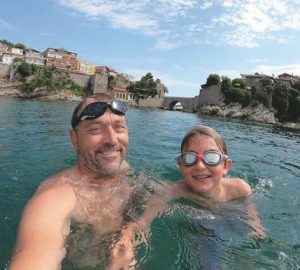Eleven Ways to Cope with the Chlorine Box
Becoming an outdoor swimmer can completely change your view of swimming pools. What you once thought of as warm becomes stifling; the walls you used to hang on to for a rest are now barriers, forcing you turn repeatedly; the aroma of chlorine now seems sterile and dead rather than sanitising. Some people, once they’ve caught the open water bug, can never go back indoors. They can no longer cope with the smell, the crowds, the cost or the lane rage. Still, swimming pools have their uses. Approached wisely, they are good places to practise technique and train in a controlled environment. In winter, it can be difficult to swim for long enough outside to improve or maintain fitness. So, if you are venturing into the chlorine box, here are our tips to make the most of it.
1. Swim with friends
Swimming with others always seems to make it more enjoyable. It also makes it easier to complete a training set or session. It’s all too easy to give up when you start to feel tired if you swim on your own. Having someone else in the lane doing the same thing gives you that extra bit of motivation you sometimes need to keep going.
2. Have a goal or a dream
It doesn’t matter whether it’s maintaining your fitness, recovering from injury, building your confidence for your first open water swim or doing the Oceans Seven, having a goal or dream will give you added reason (apart from the sheer pleasure of swimming) to swim and keep to your schedule.
3. Have a plan for each swim session
As well as your big goal or dream, have a plan for each swim. This could be a simple target distance to swim or a complicated session plan with detailed instructions for warming up, drills, main set and cool-down. If you know beforehand what you want to do, you’ll be more likely to do it.
4. Be flexible
Compared to open wall, pools are very predictable. You know what the water temperature will be and the length of the pool. If it’s inside, it doesn’t matter what the weather is doing. What you can’t control, however, is other people. If the presence of other swimmers makes your planned session impossible, don’t get angry, be flexible. What can you change to make it easier to fit in with the other swimmers?
5. Pick your time
This will require trial and error as every pool has its own schedules, and you will have to find slots that fit with your life and other demands on your time. If you want a decent practice session, you will need to find a relatively quiet slot with lane swimming, and when the other people swimming are of a similar speed. There are definitely times when public pools are less busy than others.
6. Establish a routine
If you frequently swim at the same time and place each week you’ll get to know the other people who do the same. With a bit of luck and some polite communication efforts on your part, you should be able to reach agreement on how to share the lane in a way that allows you all to do the swim you want to do. We don’t want to be prescriptive about lane etiquette and who should do what when as we know that will result in inconclusive (and vitriolic) debate but if you’re considerate and friendly it should be fine.
7. Join a club or swimming group
Swimming with a club or organised group can be a big boost to your swimming. Yes, you’ll need to do what you’re told to fit in with everyone else in your lane but the flip side is you can have a swim uninterrupted by people pushing off in front of you, swimming breaststroke in the freestyle lane (or vice versa) or all the other annoyances that come with a public session. If you can’t find a suitable masters swimming club then (dare we say it), a triathlon group can be a great choice. In fact, for people who haven’t swum at a high level as kids, triathlon groups are often more accommodating.
8. Always work on technique
Technique shouldn’t be something you reserve for doing drills or exercises. Work on it with every stroke you take. Choose a technique point you want to improve and keep focused on it all the time you swim. Be selective. There are many things you could work on to swim faster, but you can’t change them all at once. Get advice from a good coach, select your top three learning points and focus only on those, preferably one at a time. After you’ve worked on those for a few weeks, see the coach again and get some new things to work on. Don’t switch off and just swim.
9. Measure and monitor
Keep track of how fast you swim and how many strokes you take per length. As you make changes to your technique, monitor to see what happens to how long it takes you to swim a certain distance, how many strokes it takes you and how much effort you have to put in. This will give you immediate feedback on whether or not you’re improving.
10. Swim other strokes
Whatever your preferred stroke in open water, try to mix it up more when you’re in the pool. It’s fun.
11. Look out for discounts
Pool swimming can be expensive but many pools offer memberships or other discount options to help reduce the cost a little. If you swim at a leisure centre but never use the gym, ask if there’s a swim-only membership option or see if you can you get discounted membership through your work. If your pool is owned by the local council, see if they have discount schemes for residents or people who work in the borough.
Picture: (c) Arena






